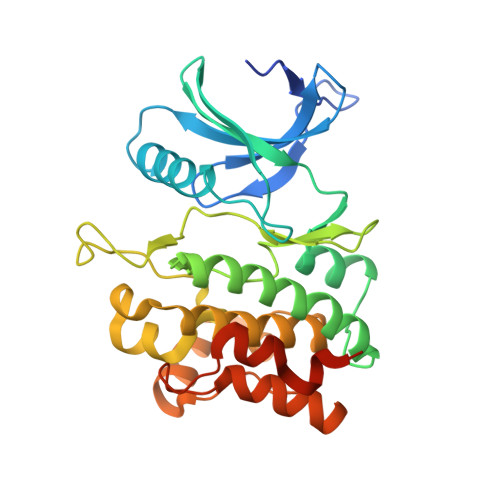Rational approach to highly potent and selective apoptosis signal-regulating kinase 1 (ASK1) inhibitors.
Lovering, F., Morgan, P., Allais, C., Aulabaugh, A., Brodfuehrer, J., Chang, J., Coe, J., Ding, W., Dowty, H., Fleming, M., Frisbie, R., Guzova, J., Hepworth, D., Jasti, J., Kortum, S., Kurumbail, R., Mohan, S., Papaioannou, N., Strohbach, J.W., Vincent, F., Lee, K., Zapf, C.W.(2017) Eur J Med Chem 145: 606-621
- PubMed: 29348070
- DOI: https://doi.org/10.1016/j.ejmech.2017.12.041
- Primary Citation of Related Structures:
5VIL, 5VIO - PubMed Abstract:
Many diseases are believed to be driven by pathological levels of reactive oxygen species (ROS) and oxidative stress has long been recognized as a driver for inflammatory disorders. Apoptosis signal-regulating kinase 1 (ASK1) has been reported to be activated by intracellular ROS and its inhibition leads to a down regulation of p38-and JNK-dependent signaling. Consequently, ASK1 inhibitors may have the potential to treat clinically important inflammatory pathologies including renal, pulmonary and liver diseases. Analysis of the ASK1 ATP-binding site suggested that Gln756, an amino acid that rarely occurs at the GK+2 position, offered opportunities for achieving kinase selectivity for ASK1 which was applied to the design of a parallel medicinal chemistry library that afforded inhibitors of ASK1 with nanomolar potency and excellent kinome selectivity. A focused optimization strategy utilizing structure-based design resulted in the identification of ASK1 inhibitors with low nanomolar potency in a cellular assay, high selectivity when tested against kinase and broad pharmacology screening panels, and attractive physicochemical properties. The compounds we describe are attractive tool compounds to inform the therapeutic potential of ASK1 inhibition.
Organizational Affiliation:
Medicine Design, Pfizer, Inc., 1 Portland Street, Cambridge, MA 02139, USA. Electronic address: frank.lovering@pfizer.com.















